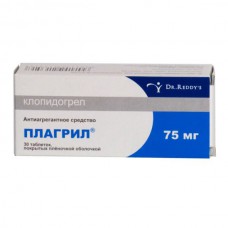Expiration date: 08/2026
The composition and form of issue:
Tablets, film-coated. 1 tablet contains:
clopidogrel hydrosulfate 97,875 mg
(equivalent to 75 mg clopidogrel)
other ingredients: microcrystalline cellulose (Avicel PH 112) — 211,125 mg mannitol — 58 mg croscarmellose sodium 12 mg colloidal silicon dioxide 2 mg magnesium stearate 4 mg
shell: Opadry pink 03?54202 (polymer 62,5%, titanium dioxide 30,6%, macrogol 400 6.25%, the colorant iron oxide red 0,65%) — 13,475 mg
blistere in 10 PCs. in cardboard pack of 3 or 10 blisters.
Description pharmaceutical form:
Round, biconvex tablets, film-coated pink color, embossed "127" on one side.
Pharmacokinetics:
Absorption and distribution. Absorption and bioavailability of high concentration in the plasma is low and through 2 hours after admission does not reach the measurement limit (0,025 µg/l). Clopidogrel and the main metabolite bind reversibly with plasma proteins (98% and 94%, respectively).
Metabolism. Metabolized in the liver. The main metabolite — inactive derivative carboxylato acid of about 85% circulating plasma connection. Tmax of the metabolite after repeated oral doses of clopidogrel 75 mg hours (Cmax about 3 mg/l). Clopidogrel is a precursor of the active substance. Its active metabolite, tilne derivative, formed by oxidation of clopidogrel to 2-oxo-clopidogrel and subsequent hydrolysis. The oxidation process is regulated primarily by the isoenzymes of cytochrome ?4502?6 and 3A4 and, to a lesser extent by 1A1, 1A2 and 1?19. Carbothiolic active metabolite quickly and irreversibly binds to the platelet receptor, inhibiting, thus, platelet aggregation. This metabolite in plasma is not detected.
Excretion. Excreted: kidneys — 50%, bowel — 46% (during 120 h after injection). T1/2 the main metabolite after single and repeated administration is 8 h. the concentration of secreted metabolites by the kidneys — 50%.
Pharmacokinetics in special clinical cases. The concentration of the main metabolite in plasma after ingestion of clopidogrel in a dose of 75 mg/day lower in patients with severe diseases of the kidneys (Cl creatinine 5-15 ml/min) compared with patients with kidney disease of moderate severity (creatinine Cl 30 to 60 ml/min) and healthy people.
Although ingibiruty effect on ADP-induced platelet aggregation was reduced (25%) compared to same effect in healthy volunteers, bleeding time was lengthened to the same extent as in healthy volunteers who received clopidogrel at a dose of 75 mg/day.
In patients with liver cirrhosis clopidogrel in a daily dose of 75 mg for 10 day was safe and well tolerated. Cmax of clopidogrel after administration of a single dose and at steady state, was much higher in patients with liver cirrhosis than in healthy subjects.
Description pharmacological action:
Specific inhibitor of platelet aggregation, has koronarorasshiryayuschee effect. Selectively reduces the binding of ADP receptors on platelets and activation of receptor GPIIb/IIIa by the action of ATP, weakening, thus, platelet aggregation.
Reduces agregatia platelets, caused by other agonists, preventing activation of the released ADP, does not affect the activity of phosphodiesterase (PDE). Irreversibly binds to ADP-receptors platelets, which remain impervious to the stimulation of ADP throughout the life cycle (about 7 days). Inhibition of platelet aggregation observed after 2 h after administration (40% inhibition) initial dose of 400 mg. the Maximum effect (60% suppression of aggregation) develops after 4-7 days of admission in a dose of 50-100 mg/day. Antiplatelet effect lasts for the entire period of life of platelets (7-10 days). Platelet aggregation and bleeding time return to baseline levels, on average, 5 days after cessation of treatment.
In the presence of atherosclerotic lesions of the vessel prevents the development of atherothrombosis regardless of the localization of vascular process (cerebrovascular, cardiovascular or peripheral lesions).
Indications:
- prevention of thrombotic complications in patients with myocardial infarction, ischemic stroke or peripheral arterial occlusion
- prevention of thrombotic complications in acute coronary syndrome: ST-segment elevation when possible, use of thrombolysis without ST-segment elevation (unstable angina, myocardial infarction without Q wave), including patients undergoing stenting in combination with acetylsalicylic acid.
Contraindications:
- hypersensitivity to the drug
- severe liver failure
- hemorrhagic syndrome, acute bleeding (including intracranial hemorrhage) and disease, predisposing to the development (ulcers disease stomach and duodenal ulcer in the acute stage, ulcerative colitis, tuberculosis, lung tumor, hyperfibrinolysis)
- pregnancy
- lactation (breast-feeding)
- children up to age 18 years (safety and efficacy not established).
With caution:
- moderate hepatic and/or renal failure
- injuries and conditions that increase the risk of bleeding (including surgery)
- simultaneous treatment with acetylsalicylic acid, NSAIDs (including COX-2 inhibitors), heparin and inhibitors of receptor glycoprotein IIb/IIIA.
Side effects:
Depending on frequency of occurrence there are following groups of side effects: frequent — more than 1% infrequent — 0,1–1% rare 0.01 to 0.1% is very rare — less than 0.01%.
From the blood coagulation system: often — gastrointestinal bleeding, rarely — haemorrhagic stroke, prolonged bleeding, epistaxis rare — hematoma, hematuria, and conjunctival hemorrhage.
With the hematopoietic system: rarely — thrombocytopenia, rarely — neutropenia, leukopenia, eosinophilia, rarely — thrombocytopenic purpura and granulocytopenia, agranulocytosis, anaemia and aplastic anemia.
CNS and peripheral nervous system: rare — headache, dizziness, paresthesia, rarely, vertigo very rarely — confusion, hallucinations.
From the side of cardiovascular system: very rarely — vasculitis, decrease in blood pressure.
The respiratory system: very rarely — bronchospasm, interstitial pneumonitis.
From the digestive system: often — neuralgia, diarrhea, abdominal pain, rarely — nausea, gastritis, flatulence, constipation, vomiting, pitting mucous membrane syndrome, the aggravation of gastric ulcer and duodenal ulcer very rarely — colitis (including ulcerative or lymphocytic), pancreatitis, changing taste sensations, stomatitis, hepatitis, acute liver failure, increased liver enzymes.
The skeletal-muscular system: very rarely — arthralgia, arthritis, myalgia.
From the side of urinary system: very rarely — glomerulonephritis.
Dermatological reactions: infrequently — itching, very rarely — bullous rash (erythema multiforme, Stevens-Johnson syndrome, toxic epidermal necrolysis), rash erythematous, eczema, flat lichen.
Allergic reactions: very rarely — angioneurotic edema, urticaria, anaphylactoid reactions, serum sickness.
Other: very rarely — fever, increase in blood creatinine.
Drug interactions:
Enhances the antiplatelet effect of acetylsalicylic acid, heparin, indirect anticoagulants, NSAIDs, in a joint application increases the risk of bleeding from the gastrointestinal tract. By inhibiting the activity of CYP2C9, increases the concentration of drugs metabolized with the participation of CYP2C9 (phenytoin, tolbutamide).
Not clinically significant pharmacodynamic interaction with clopidogrel use in conjunction with atenolol, nifedipine, phenobarbital, cimetidine, estrogens, digoxin, theophylline, tolbutamide, antacids.
Method of application and dose:
Inside, regardless of meals.
For prevention of coronary abnormalities in patients after myocardial infarction, ischemic stroke or on the background of diagnosed diseases peripheral arteries: adults (including elderly patients) is prescribed 75 mg 1 time per day. Treatment should begin within the period of 35 days after suffering a Q-forming myocardial infarction and from 7 days to 6 months after ischemic stroke.
In acute coronary syndrome without ST segment elevation (unstable angina or myocardial infarction without Q-wave formation): treatment should begin with the appointment of a single loading dose 300 mg, then continue use of the drug in a dose 75 mg 1 times per day (with the simultaneous intake of acetylsalicylic acid at a dose 75-325 mg/day). Since the use of acetylsalicylic acid in high doses is associated with a greater risk of bleeding, the recommended dose should not exceed 100mg. the Course of treatment — up to 1 year.
In acute coronary syndrome with ST segment elevation (acute myocardial infarction): the drug appoint one dose 75 mg 1 times per day, using an initial loading dose in combination with acetylsalicylic acid, in conjunction or without thrombolytics. For patients older than 75 years, treatment with clopidogrel should be undertaken without the use of a loading dose. Combination therapy is started as early as possible after the onset of symptoms and continued for at least 4 weeks.
Overdose:
Symptoms: when a single oral administration of 600 mg of clopidogrel (the quantity equivalent to 8 standard 75 mg tablets) in healthy people, the side effects were not. The bleeding time was lengthened by 1.7 times, which corresponds to the value recorded after administration of a therapeutic dose (75 mg/day).
Treatment: platelet transfusion. There is no specific antidote.
Special instructions:
In the case of surgery if antiplatelet effect is undesirable, the treatment should be discontinued 7 days before surgery.
Patients should be warned that because the stop occurs on a background of the drug bleeding requires more time, they should inform the doctor about each case, unusual bleeding. Patients should also inform the doctor about the drug if they have surgery or if the doctor prescribes new drugs to the patient.
During treatment necessary to monitor the hemostatic parameters (APTT, the number of platelets, tests of functional activity of platelets) regularly examine the functional activity of the liver.
In severe liver dysfunction should be aware of the risk of developing a hemorrhagic diathesis.
Effects on ability to drive vehicles and management mechanisms. Signs of deterioration in the ability of car control or reduction of mental health after ingestion were found.


